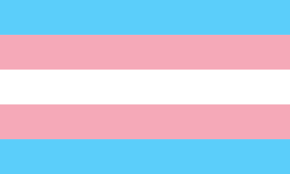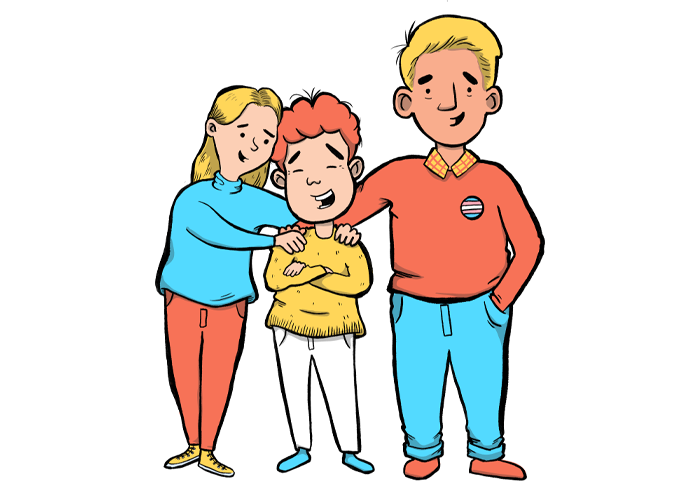Definitions and status of trans children

It is important to recognize and support the gender identity and gender expression of trans children, as well as their choice of name. Education for those working with trans children as well as their immediate family is an important part of improving their well-being, but there is also a need to change the structure and organization of institutions such as schools and after-school programs.
Gender identity
Gender identity is about one’s own sense and feelings of gender. It has to do with how we want to live and be gendered beings. Gender identity has nothing to do with genetics, biology ,or appearance, it has to do with our experience of our own gender. Some people identify as men, some people identify as women, some people identify as both, others identify as neither a woman nor a man. Our gender identity is what dictates whether we are trans or cis (cisgender). Related to this is the issue of assigned sex, which refers to the gender that is assigned to us at birth based on genitalia and is therefore not the same as gender identity.
Gender Expression
Gender expression is how we express our gender, for example, how we dress, carry ourselves, talk, cut our hair, and how our general manner is. In general, gender expression is viewed on the feminine-masculine spectrum, but it can be diverse and does not have to be consistent with the assigned gender. Being transgender or non binary should not be confused with gender diversity or non-confirming gender expression or behavior, such as a boy who plays a lot with dolls and loves skirts and nail polish. If he identifies as a boy, then he is cis. But transgender children, just like cisgender children, can have all kinds of gender expression and interests regardless of gender.
Trans, Cis, and Gender
People who experience congruence between their gender identity and their assigned gender are cis or cisgender, people who experience incongruence between their gender identity and assigned gender are trans. However, people have varying experiences and identities and it is up to the people themselves to decide which terms they wish to use about themselves. Children might associate with and use the term trans, others may not use that term and simply speak of themselves as girls or boys (or non-binary (stálp)).
- A child who identifies with their assigned sex at birth is most likely cis (the opposite of trans).
- A child who identifies as a girl, but was assigned male at birth, is most likely a trans girl.
- A child who identifies as a boy, but was assigned female at birth, is most likely a trans boy.
- A child who experiences themself as neither a girl nor a boy, or a mixture of both, or sometimes a girl and sometimes a boy, is most likely non-binary.
Gender & Pronouns
An Icelandic term for non-binary adults is “kvár”. An Icelandic term for non-binary children is “stálp”. These terms are comparable to other gendered terms we use for adults and children such as woman, man, girl and boy. Non-binary people often use gender-neutral pronouns like they/them (hán), but there are a few pronouns in use, and it's always best to ask if you have any doubts. It is important to remember that pronouns such as they/them or hán are not nouns or names, and it is important to do your best to use it correctly.
|
Woman
|
Man
|
Non-binary adult (kvár)
|
|
Girl
|
Boy
|
Non-binary child (stálp)
|
|
She
|
He
|
They (hán*)
|
*Note that there are more gender-neutral pronouns in use and it is good to ask them if you do not know which first name to use.
Status of trans children and support
There is no one right way to come out and be transgender—this is usually a process that takes time. The most important thing is to provide a child with visible and active support. It is also good to be aware that there is no test or observation that can tell whether a child is transgender or cisgender. Likewise, there is nothing that will make a child either transgender or cisgender. What can be controlled is the context and support that the child experiences.
Professional experience shows that trans children experience anger, anxiety, and depression, are at risk of self-harm, have a tendency towards eating disorders, and deal with other mental health problems in a higher proportion than cis children. This is particularly true in those trans children who experience silence and suppression of their gender identity. It is key, therefore, that trans children receive support and respect, especially from their immediate families. You can read books about trans children both for adults and also with children to increase knowledge and open up conversations about feelings, gender, and gender identity.
When a child is coming out as trans, or with a different gender identity than expected, it is good for providers and immediate family members to seek advice and support. You can obtain this free of charge from Samtokin '78, which offer counseling service and maintain a support group for the trans children’s next of kin. Official assistance to trans children and adults within the health system is tied to the diagnosis of gender dysphoria and takes place at Landspítali’s Psychiatric Department and BUGL (Child and Adolescent Psychiatric Department). Trans children can have their name and gender registration changed at Registers Iceland when they reach the age of 15, but before that, they can get these changes made with the consent of their guardians.

Gender affirmation
For transgender children, we usually talk about social gender affirmation. This could mean growing out/cutting their hair, changing their clothing, behavior, other forms of expression, and using a different name and pronouns. Such changes are often simple and non-permanent, but very important and meaningful for the child involved. Children do not undergo surgeries or permanent changes to their bodies.
For transgender adolescents, social gender affirmation is equally important, but in some cases, transgender adolescents receive hormone blockers during and around puberty. The blockers effectively put puberty on hold. This is used when adolescents experience gender dysphoria (deep discomfort) related to their body and sex characteristics. If the child wants to continue puberty, the child can stop taking the hormone blocker. If the adolescent continues on the same path, they are likely to receive cross-sex hormones later. This healthcare service is provided by the Trans Team at BUGL, but an initial diagnosis is required before seeking their services.
If a transgender individual wants further measures such as cross-sex hormones and surgeries (possible at age 18), they need to consult the Trans Team at Landspítali University Hospital. Some transgender people have surgery or take hormones to change their body and appearance, thus aligning them with their gender identity, usually called sex or gender confirmation (sometimes sex or gender reassignment), part of which may never end, for instance the taking of hormones. Other transgender people may not want to undergo surgeries and/or take hormones. The experience and thus the gender affirmation of transgender people are individual and varied. But the transgender-related healthcare available to transgender people is essential.